With the new Riders series Linde Material Handling brings a comfortable alternative to the pallet trucks and stackers with foldable platform when it comes to pallet transfer, loading and unloading and block stacking. The L16 RW with its spacious seat offers a pleasant workplace especially when there is intensive work and longer driving distances. During the practical test we experience special advantages of the Rider, but we also see some points for improvement.
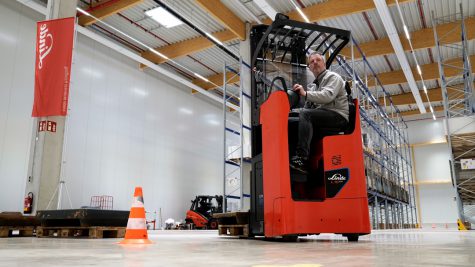 In the autumn of 2018, Linde introduced a new series of pallet trucks and (double) stackers with the addition of R (Rider) in the name. With this new R-series, Linde meets the demand for comfortable compact pallet trucks and stackers with lateral stand-in/sitting driver. The new range includes 19 different models and is available with either lead acid or Lithium-ion batteries. In this test we look at the Linde L16 RW stacker with Lithium-ion battery with 1,600 kg load capacity. With a chassis width of 970 mm this is the widest of three chassis types. The W refers to Wide, giving this truck space for a real seat with adjustable suspension. To see how the newcomer is doing against an ‘old acquaintance’ we also put the Linde L16 AP with folding platform to work on our course. We can also experience the differences of both trucks and get a better understanding in which line of work both truck types are at their best.
In the autumn of 2018, Linde introduced a new series of pallet trucks and (double) stackers with the addition of R (Rider) in the name. With this new R-series, Linde meets the demand for comfortable compact pallet trucks and stackers with lateral stand-in/sitting driver. The new range includes 19 different models and is available with either lead acid or Lithium-ion batteries. In this test we look at the Linde L16 RW stacker with Lithium-ion battery with 1,600 kg load capacity. With a chassis width of 970 mm this is the widest of three chassis types. The W refers to Wide, giving this truck space for a real seat with adjustable suspension. To see how the newcomer is doing against an ‘old acquaintance’ we also put the Linde L16 AP with folding platform to work on our course. We can also experience the differences of both trucks and get a better understanding in which line of work both truck types are at their best.
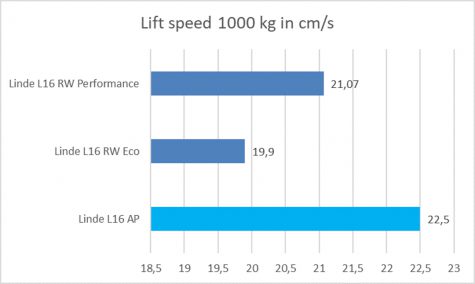 Both trucks in this test lift loads up to 1,600 kg or carry a total of 2,000 kg if a load is also taken up on the support legs. The AP lifts to 4,800 mm while the RW reaches 6,200 mm. The new Rider truck offers a higher residual load capacity. It brings the 1,600 kg up to 4,000 mm where the AP sets its limit at 3,150 mm. At the maximum height of 6,200 mm, the L16 RW can still handle a maximum load of 500 kg.
Both trucks in this test lift loads up to 1,600 kg or carry a total of 2,000 kg if a load is also taken up on the support legs. The AP lifts to 4,800 mm while the RW reaches 6,200 mm. The new Rider truck offers a higher residual load capacity. It brings the 1,600 kg up to 4,000 mm where the AP sets its limit at 3,150 mm. At the maximum height of 6,200 mm, the L16 RW can still handle a maximum load of 500 kg.
Both trucks are equipped with the Linde Load Management System that monitors both weight and lifting height. The beautiful colour display shows how much the load weighs and how high we lift. When lifting the load, the system immediately calculates the height to which the load can be safely lifted. If there is a threat of overloading, the lifting stops automatically. You can bridge this stop, which is sometimes necessary. Due to the shock between the mast sections, the display weight sometimes rises unintentionally, and the warning occurs too early. This brings us immediately to an improvement proposal: mast damping for both the incoming and outgoing second mast section. We experience the shock in the mast as not comfortable. At ground level and at maximum lift, both trucks slow down the mast neatly.
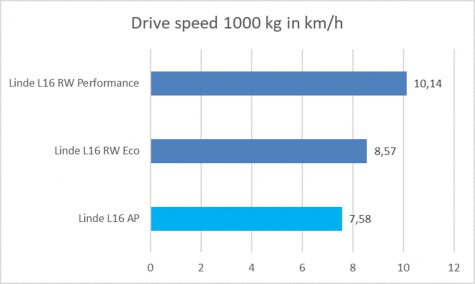 Comparing the bare performances of both trucks, the Rider scores higher values when it comes to laden and unloaded driving and acceleration. We can choose between the Performance level and a ECO level on the RW. On the ECO mode the driving speeds of the RW are almost equal to those of the AP truck. The AP on the other hand, scores slightly better on all mast performance aspects.
Comparing the bare performances of both trucks, the Rider scores higher values when it comes to laden and unloaded driving and acceleration. We can choose between the Performance level and a ECO level on the RW. On the ECO mode the driving speeds of the RW are almost equal to those of the AP truck. The AP on the other hand, scores slightly better on all mast performance aspects.
The biggest difference whoever, we experience in comfort. This is mainly caused by the good sit and working position on the RW. This truck has an adjustable footplate with the Linde double pedal to choose the direction of travel. It is clear that whoever covers long distances or tracks with many turns, is better off with the RW. The truck works easier, provides better support for the driver and reduces the risk of injury by staying within the contours of the truck. Even when the AP truck has a spacious platform, there is always the risk of feet standing over the edge on trucks with foldable platform. And driving backwards with the AP truck when handling high loads, isn’t easy for you must turn the body or your head to have a good overview on your way of travel.
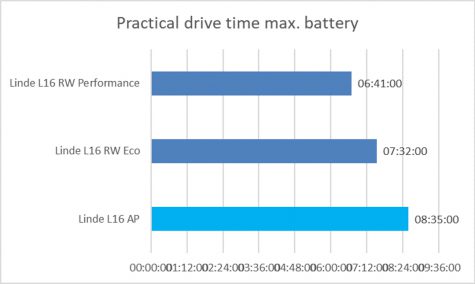 On the RW we experience a point of improvement: we would like to reduce the pedal height of the directional pedals slightly to reduce the tension on the lower leg. The pedal of the not chosen direction of travel is just too high to allow the foot to rest comfortably on the pedal.
On the RW we experience a point of improvement: we would like to reduce the pedal height of the directional pedals slightly to reduce the tension on the lower leg. The pedal of the not chosen direction of travel is just too high to allow the foot to rest comfortably on the pedal.
Of course, we are curious about the performance differences on our standard course for stackers. On this track we move four loads of 500 kg (2x), 1000 kg and 1500 kg over a total distance of 30 meters with two right angles. We always lift each load to 2,900 mm, both when picking up and leaving the load. After putting the load away, we always lift once unloaded up to 2,900 mm. We measure the time and energy required to complete this job from four different pallets.
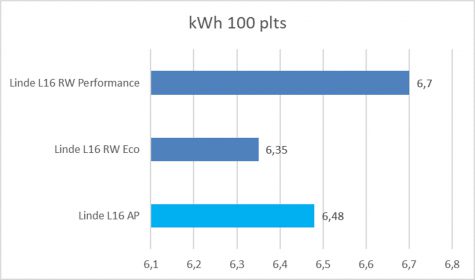 You would expect the RW to exceed the performance of the AP thanks to the higher driving speeds when the truck is set to Performance mode and this assumption is correct. Compared to the AP, the RW scores 10.4% higher productivity. This value was reached after resetting the basic values of the curve control system to our wishes and experience with other trucks. The gain would even be bigger when there was no need for the mandatory lifting of the support legs when driving. Only with risen support legs the RW will reach its maximum driving speed. Compared to other AP-type stackers in this class, the RW is almost on break even in productivity. The mentioned lifting of the support legs and the much heavier weight of the truck are the main reasons for the small gap.
You would expect the RW to exceed the performance of the AP thanks to the higher driving speeds when the truck is set to Performance mode and this assumption is correct. Compared to the AP, the RW scores 10.4% higher productivity. This value was reached after resetting the basic values of the curve control system to our wishes and experience with other trucks. The gain would even be bigger when there was no need for the mandatory lifting of the support legs when driving. Only with risen support legs the RW will reach its maximum driving speed. Compared to other AP-type stackers in this class, the RW is almost on break even in productivity. The mentioned lifting of the support legs and the much heavier weight of the truck are the main reasons for the small gap.
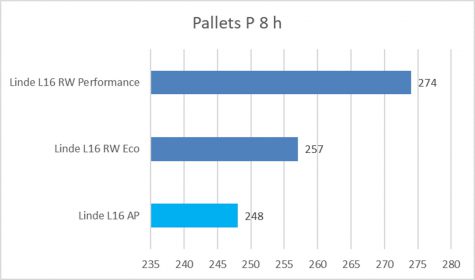 When it comes to the energy efficiency, the AP truck takes the lead. It is no wonder: the RW truck has a bigger driving motor and bears a much higher weight. The RW’s higher dead weight is 1616 kg, and so this truck is more than 500 kg heavier than the AP. The extra weight of the higher mast is even not included. The RW’s slightly more energy-efficient Li-ion technology reduces the difference in energy consumption and offers much better opportunities to significantly increase the truck’s uptime thanks to the possibility of opportunity charging during coffee and lunch brakes
When it comes to the energy efficiency, the AP truck takes the lead. It is no wonder: the RW truck has a bigger driving motor and bears a much higher weight. The RW’s higher dead weight is 1616 kg, and so this truck is more than 500 kg heavier than the AP. The extra weight of the higher mast is even not included. The RW’s slightly more energy-efficient Li-ion technology reduces the difference in energy consumption and offers much better opportunities to significantly increase the truck’s uptime thanks to the possibility of opportunity charging during coffee and lunch brakes
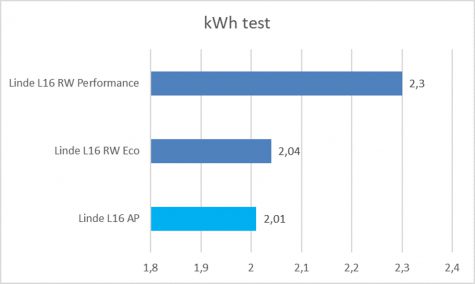 With a wide choice of new, very solidly built models of pallet trucks and stackers, Linde Material Handling offers a suitable solution for almost every application requirement. The Linde L16 RW is an ergonomic alternative to the L16 AP pallet truck. Especially if there are longer driving distances and many trips, the RW will enable the driver to work easier and, above all, safer. The truck supports the driver while seated and offers a large working space for transporting and stacking pallets. If you work a lot on uneven tailgates or loading docks and will travel short distances, you may prefer the AP. We experience the damping of thresholds and unevenness as just a little more pleasant than with the RW.
With a wide choice of new, very solidly built models of pallet trucks and stackers, Linde Material Handling offers a suitable solution for almost every application requirement. The Linde L16 RW is an ergonomic alternative to the L16 AP pallet truck. Especially if there are longer driving distances and many trips, the RW will enable the driver to work easier and, above all, safer. The truck supports the driver while seated and offers a large working space for transporting and stacking pallets. If you work a lot on uneven tailgates or loading docks and will travel short distances, you may prefer the AP. We experience the damping of thresholds and unevenness as just a little more pleasant than with the RW.
In our opinion, the improvements for the new Rider range will be: a good mast damping between the mast sections and a reduced height of the driving pedals. Furthermore we achieved a more pleasant, predictable driving behaviour of the truck while testing by adjusting the factory settings of the Curve Control regarding “steering impact” and “speed reduction”. A major advantage of both test trucks is the Linde Load Management System, which continuously keeps an active and safe eye on the handling of palletized loads.
(Text and photos: AndersomTesting, Theo Egberts and Mark Dohmen)
Tags:
Andersom test, Andersom testing, Forklift test, Intralogistics, Linde, Linde L16, Linde L16 RW, Linde Material Handling, Test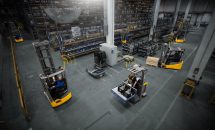
Jungheinrich is bringing a completely redesigned modula...

The IFOY TEST DAYS and TEST CAMP Intralogistics will t...

One-millionth counterbalance truck produced in Aschaff...